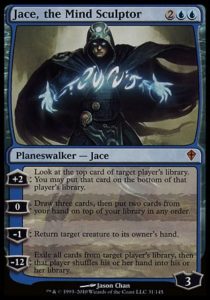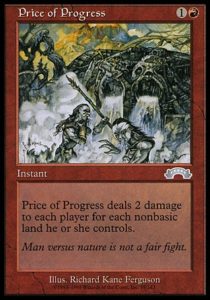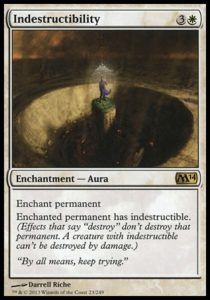It’s been five years and both Jace and Standard have come full circle.
Five years ago, in August 2010, I returned to Magic after a decade’s absence. By November, I decided to be as competitive as I could (and started losing a healthy amount at the late night team drafts which inevitably followed drafts at Jim Hanley Universe). This decision dramatically changed my life: it eventually pushed me to set aside performing and the prospect of law school to become a game designer (not to mention all of the friendships and good times I’ve had as a consequence of Magic).
I decided to focus only on Limited. This was a no-brainer: not only is it the best way to play, but Standard had a steep barrier to entry: at the time, one had to either drop $200 on a playset of [casthaven]Primeval Titan[/casthaven]s or $400 on a playset of [casthaven]Jace, the Mind Sculptor[/casthaven]s (or, okay, play [casthaven]Goblin Guide[/casthaven], but monored didn’t seem like a good or fun deck). After that, you still had to decide on and acquire the remaining 71 cards.
For the past five years, I always flirted with building a Standard deck, but never got around to it (except when forced to build Bant Hexproof for one tournament—the Twenty Sided Store Championship). Limited and Modern were too much fun and Standard always seemed like a bad choice. Committing to acquiring a Modern deck, while more expensive than buying a Standard deck all at once, one can do slowly and the deck will still be legal if it takes half a year to get. Continually having and upgrading a Standard deck just feels more expensive and exhaustive in the long run. Accordingly, I never did it.
We’re currently at one of the easier junctures to get into Standard. The format is mature, so people know what decks are good, as well as that the format is fun and diverse. A new set is about to come out, which will shake things up, but it won’t be a rotation, so no cards are about to lose their value or decks about to die (unless a brand new archetype comes out or a particularly strong hoser becomes available). A large number of the BfZ boosters that will be opened have been opened (and far fewer will be opened from here on, now that the Limited format is well explored and Oath of the Gatewatch draft will have two packs of the new set to BFZ’s one), so BfZ staples are likely close to the lowest price they’ll be until rotation (either the rotation that makes them leave Standard or the rotation which removes the archetype enablers they need to function). Financially and relatively speaking, the format is low risk and relatively low cost to get into.
I could complain that this is the most expensive Standard environment of all time, but I won’t. Standard is always going to be expensive, and competitive Standard decks are always going to require the most expensive cards (those cards are expensive chase cards because they’re necessary for Standard, the most popular Constructed format). That this particular Standard is so expensive is a deviation from the norm, but one that will invariably happen, given enough time (and inflation). Moreover, this Standard owes much of its price to the fetchlands, which are valuable, Eternal staples and combine with Battle lands to enable decks to play all the good cards, making them necessary for a staggering percentage of decks.
Playing Standard is always going to be a daunting enterprise for someone who isn’t already playing Standard, has a comfortable bankroll, or has affluent-enough friends/sponsors to lend them cards. That’s just a consequence of Magic’s business model and the secondary market.
My problem with Standard has always been the feeling of spending $500+ to rent a deck for a year or two (or now, six to eighteen months). I say this having worked on Kingdom Death: Monster, a game which retails for $400 (and that’s just the core game—it doesn’t include the three expansions I designed for). Kingdom Death, or a Playstation 4, is something you’ll always have and always be able to use (barring hardware failure). Sure, the PS4 will eventually be replaced by something newer and you might set aside the console or game, but you’ll always have them. A Modern deck might cost more than twice as much as a Standard deck, but it’ll always be Modern legal (barring bannings or the death of Magic).
A Standard deck doesn’t have that longevity. Sure, you’ll continue to own the cards, but they won’t be the Standard deck you acquired (they’ll be random Modern cards, most of which don’t have a home anywhere anymore). Sure, you’ll probably have received hundreds of dollars of intangible benefits from playing Standard (not to mention potential cash or booster prizes), but I prefer my substantial financial investments in games to either have a lower upfront cost or a longer lifespan. And so I draft and play Modern.
It’s been five years. Jace is still the most expensive and powerful card in Standard. I still don’t want to spend the money on him or Standard. I can wait to acquire him for Modern until he rotates out. I can wait until next Standard rotation, when I can kid myself that this year will be the year I make the plunge. Perhaps five years from now, we’ll be back in this same spot again, with a busted Jace and me still not playing Standard.
And then I’ll say, as I do now, thank you for reading.
—Zachary Barash
Zachary Barash has been playing Magic on and off since 1994. He loves Limited and drafts every available format (including several that aren’t entirely meant to be drafted). He’s a proud Cube owner, improviser, and game designer (currently going for an MFA in Game Design at NYU). He has an obsession with Indian food that borders on being unhealthy.




